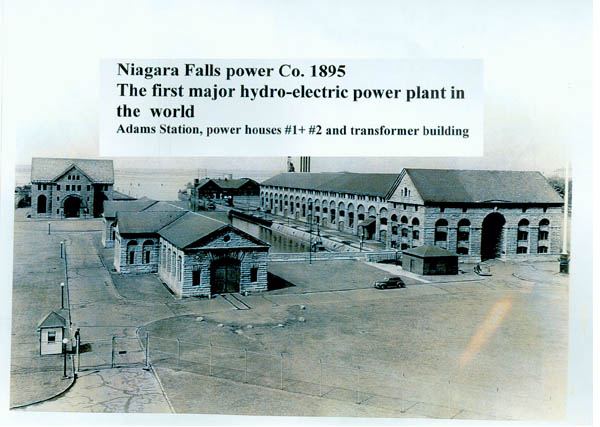Article: Tesla's Falls
- Due Jan 25, 2018 at 11:59pm
- Points 100
- Questions 3
- Available Dec 4, 2017 at 7:30am - Jan 29, 2018 at 11:59pm
- Time Limit None
- Allowed Attempts Unlimited
Instructions
Tesla Harnesses Niagara Falls
This article was originally published in the May 5, 1896, edition of The New York Times. It describes the Electrical Exposition taking place in New York City's Grand Central Palace. The exposition was mounted to display the latest inventions and the many uses of electricity. Its highlight was the turning on of the first major hydroelectric power plant in the world, designed by Nikola Tesla. Hydroelectric power plants use the force and energy of water to create electricity. Tesla's harnessed the power of the mighty Niagara Falls.

The Electrical Exposition was formally opened by New York Governor Levi P. Morton at 8:30 last night. The opening ceremony took place at New York City's Grand Central Palace.
When the proper moment arrived, the governor pressed the gold telegraph key. An electric current generated at Niagara Falls was then sent over the Western Union Telegraph lines. Immediately, the governor was surrounded by two bands of light generated by high-tension currents of electricity in long vacuum tubes. The currents came from the Niagara Power Co.’s generators. It passed through New Orleans, Louisiana; San Francisco, California; St. Paul, Minnesota; and Augusta, Maine, before returning to Niagara Falls. As it traveled, it fired off cannons in each of these cities.
Between 6,000 and 7,000 people had assembled in the Grand Central Palace's main hall to watch the demonstration. Before the arrival of the governor, Commodore Perry Vedder gave a rousing and thought-provoking speech. Electricity, he said, was the mighty miracle of the 19th century. It had become central to man’s progress and well-being. It had made work easier, and therefore had decreased the hours during which he had to work.
Closing The Distance Through Electricity
Mr. Vedder went on to say that Benjamin Franklin, Thomas A. Edison and Nikola Tesla had given the world many marvels. Thanks to the harnessing of electricity, men could now talk to each other as if they were face to face even when they were 5,000 miles apart. Such wonders might be just the beginning, Mr. Vedder added. Other great new discoveries may follow very soon.
Morton then arrived and soon began his own remarks. The governor said he felt deeply honored to be the one to release the electric current generated by the power of the great Niagara Falls.
The governor then touched the key. Those in the audience expected to hear the cannon on the roof go off in response. For some reason this cannon did not fire. However, those stationed at New Orleans, San Francisco, St. Paul and Augusta all exploded at the proper second, as telegrams from these cities soon proved.
Exhibits Demonstrate Many, Varied Uses
As the telegrams poured in, the thousands of visitors in attendance eagerly inspected the exposition's various exhibits. Each was lavishly lit up with electric lights.
The model of the Niagara Falls Power Co. naturally attracted the most attention. It contained a section model of the powerhouse and the machinery that turn Tesla's electric generators. Alongside of this model are about 20 telephones connected by wire with receivers placed near the Niagara Falls. They enable visitors to hear the roar of the great waters. Other exhibits throughout the hall demonstrate some of the many marvelous ways in which electricity can be used.
Heat. Lights. Sound.
The Edison Electric Illuminating Co.'s exhibit attracted a great deal of attention. It demonstrates electric cooking in all its phases, as well as electric ironing, bed warmers and radiators. All supplied heat without giving off any unpleasant gas.
The General Electric Co. has a tasteful exhibit. A room has been fitted up with electric lights that are themselves invisible, but which, by means of reflectors, light every part of the room with a soft and gentle radiance. The Westinghouse Co. has a fine exhibit, which shows one of Tesla’s sound generators at work.
Mr. Tesla’s discovery of disconnected light is also exhibited here. An ordinary lightbulb is separated from an electromagnet by a sheet of glass. Yet, the light glows in it as brightly as if the wires of the bulb were connected to a regular source of electricity. The bulb can even be lifted off the electromagnet and held some distance from it without the light going out.
Electricity, Then And Now
There is also an historical exhibit, which illustrates the development of electricity, from its modest beginnings to its current uses. The designs for early discoveries in telegraphy, telephones, electric lighting and electric railways are shown here. So too are models of some of Edison's early inventions.
 W.J. Hammer offers an exhibit containing an historical collection of electric lamps. A selection of historic wires and cables are also shown as well. They include a piece of the first Atlantic cable, a piece of the first wire over which S.F.B. Morse sent his message, a section of the first telephone wire and a section of the first trolley wire. Finally, Professor Elihu Thomson exhibits a very complete collection of generators, illustrating their growth and development.
W.J. Hammer offers an exhibit containing an historical collection of electric lamps. A selection of historic wires and cables are also shown as well. They include a piece of the first Atlantic cable, a piece of the first wire over which S.F.B. Morse sent his message, a section of the first telephone wire and a section of the first trolley wire. Finally, Professor Elihu Thomson exhibits a very complete collection of generators, illustrating their growth and development.